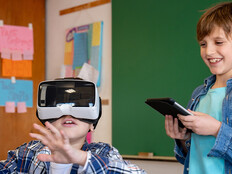Video Games Can Be as Valuable as Textbooks in Teaching History
They say that a good book can make history come to life, but with the advanced graphics and immersive experiences offered by modern video games, history is alive and kicking in a way that’s already captured the mindshare of digital natives.
KQED’s Mind/Shift blog reports on Jeffrey Mummert, a social studies teacher at Hershey High School in Pennsylvania, and his unique approach to teaching history through video games.
In “World of Warcraft,” players control characters of the “human” race who happen to look European, while the enemy race, the Orcs, have clear Middle Eastern undertones, he says. He uses the game to spark discussions about race, society and stereotypes.
Other games offer a much more straightforward link to history lessons:
A few games developed in the last three or four years are actually based on historical moments — a social studies teacher’s dream, Mummert says. One game that he’s found useful is called Skyrim Elder Scrolls V, set in medieval times that has many “non-player characters,” people in the game that a player can interact with, but that are not controlled by the player. “I’ve actually used it with my class to do field work within a game,” Mummert said. He’s asked students to take population statistics and analyze whether the towns are producing enough food to feed the population. “It’s an interesting way for an AP Human Geography teacher to get kids to think about how field work works and how to use statistics to try to change things,” he said.
Another game his students have enjoyed analyzing is Assassins Creed III, which is set in revolutionary America. After watching the trailer, his class discussed how the game was marketed differently in the United States and in Canada. The trailer depicts scenes from the Boston Massacre in a recreation that many experts say is quite realistic. Talking about what is fact and fiction within the game and whether it can be harmful to misrepresent the truth helps students understand the idea of authenticity.
The value of using real games versus games tailor-made for K–12 is the same principle that is driving the bring-your-own-device trend in mobility. By tapping into the students’ preferences, teachers can compete with the other Xbox or PlayStation games students are already playing, which increases the likelihood that students will engage with the lessons, Mummert writes in his post on the Play the Past blog.
In the post, Mummert also elaborates on why he believes video games offer a richer learning experience than textbooks.
Playing, thinking about, talking about, writing about games, I believe, expands activity to another dimension — one that includes creative and critical thought, as well as what Ian Bogost terms “procedural rhetoric.”
Rather than training students to identify and practice the strategies of rhetoric through reading and writing, what if a media existed (and the students regularly engaged in it) that communicated ideas, arguments, and points of view through its procedure, rather than in a linear set of carefully structured arguments? In this case, learning is at least 3D — it includes the dimensions of experience, agency, and action.
What if these “procedural” experiences became the basis for the acquisition of knowledge, the application of that knowledge, but also the evaluation of the “procedure” for effectiveness and/or authenticity? What if students countered an inauthentic or ineffective experience by creating one of their own?
Has your school deployed video games in the classroom in an unconventional way, as described by Mummert? We’d love to hear about it in the comments.








